formerly eScholarship Editions


|
|
|
|
Your request for similar items found 20 book(s). | Modify Search | Displaying 1 - 20 of 20 book(s) | |
| 1. | 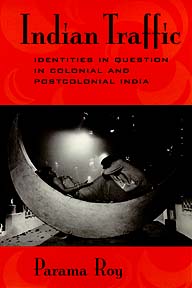 | Title: Indian traffic: identities in question in colonial and postcolonial India Author: Roy, Parama Published: University of California Press, 1998 Subjects: Postcolonial Studies | Literary Theory and Criticism | South Asia | Gender Studies Publisher's Description: The continual, unpredictable, and often violent "traffic" between identities in colonial and postcolonial India is the focus of Parama Roy's stimulating and original book. Mimicry has been commonly recognized as an important colonial model of bourgeois/elite subject formation, and Roy examines its place in the exchanges between South Asian and British, Hindu and Muslim, female and male, and subaltern and elite actors. Roy draws on a variety of sources - religious texts, novels, travelogues, colonial archival documents, and films - making her book genuinely interdisciplinary. She explores the ways in which questions of originality and impersonation function, not just for "western" or "westernized" subjects, but across a range of identities. For example, Roy considers the Englishman's fascination with "going native," an Irishwoman's assumption of Hindu feminine celibacy, Gandhi's impersonation of femininity, and a Muslim actress's emulation of a Hindu/Indian mother goddess. Familiar works by Richard Burton and Kipling are given fresh treatment, as are topics such as the "muscular Hinduism" of Swami Vivekananda. Indian Traffic demonstrates that questions of originality and impersonation are in the forefront of both the colonial and the nationalist discourses of South Asia and are central to the conceptual identity of South Asian postcolonial theory itself. [brief] Similar Items |
| 2. | 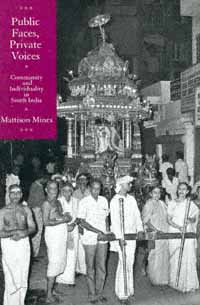 | Title: Public faces, private voices: community and individuality in South India Author: Mines, Mattison 1941- Published: University of California Press, 1994 Subjects: Anthropology | Cultural Anthropology | South Asia Publisher's Description: Individuality is often viewed as an exclusively Western value. In non-Western societies, collective identities seem to eclipse those of individuals. These generalities, however, have overlooked the importance of personal uniqueness, volition, and achievement in these cultures. As an anthropologist in Tamil Nadu, South India, Mattison Mines found private and public expressions of self in all sectors of society. Based on his twenty-five years of field research, Public Faces, Private Voices weaves together personal life stories, historical description, and theoretical analysis to define individuality in South Asia and to distinguish it from its Western counterpart.This engaging and controversial book will be of great interest to scholars and students working in anthropology, psychology, sociology, South Asian history, urban studies, and political science. [brief] Similar Items |
| 3. | 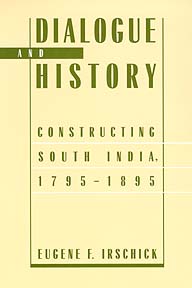 | Title: Dialogue and history: constructing South India, 1795-1895 Author: Irschick, Eugene F Published: University of California Press, 1994 Subjects: History | Asian History | South Asia | Cultural Anthropology Publisher's Description: Eugene Irschick deftly questions the conventional wisdom that knowledge about a colonial culture is unilaterally defined by its rulers. Focusing on nineteenth-century South India, he demonstrates that a society's view of its history results from a "dialogic process" involving all its constituencies.For centuries, agricultural life in South India was semi-nomadic. But when the British took dominion, they sought to stabilize the region by inventing a Tamil "golden age" of sedentary, prosperous villages. Irschick shows that this construction resulted not from overt British manipulation but from an intricate cross-pollination of both European and native ideas. He argues that the Tamil played a critical role in constructing their past and thus shaping their future. And British administrators adapted local customs to their own uses. [brief] Similar Items |
| 4. | 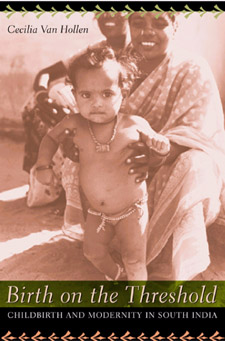 | Title: Birth on the threshold: childbirth and modernity in South India Author: Van Hollen, Cecilia Coale Published: University of California Press, 2003 Subjects: Anthropology | Cultural Anthropology | Medical Anthropology | Sociology | Gender Studies | Hinduism | South Asia | Asian Studies | South Asia | South Asia Publisher's Description: Even childbirth is affected by globalization - and in India, as elsewhere, the trend is away from home births, assisted by midwives, toward hospital births with increasing reliance on new technologies. And yet, as this work of critical feminist ethnography clearly demonstrates, the global spread of biomedical models of childbirth has not brought forth one monolithic form of "modern birth." Focusing on the birth experiences of lower-class women in the South Indian state of Tamil Nadu, Birth on the Threshold reveals the complex and unique ways in which modernity emerges in local contexts. Through vivid description and animated dialogue, this book conveys the birth stories of the women of Tamil Nadu in their own voices, emphasizing their critiques of and aspirations for modern births today. In light of these stories, author Cecilia Van Hollen explores larger questions about how the structures of colonialism and postcolonial international and national development have helped to shape the form and meaning of birth for Indian women today. Ultimately, her book poses the question: How is gender - especially maternity - reconfigured as birth is transformed? [brief] Similar Items |
| 5. | 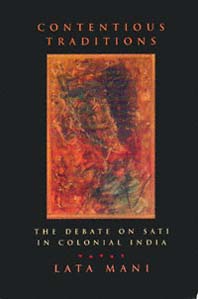 | Title: Contentious traditions: the debate on Sati in colonial India Author: Mani, Lata 1956- Published: University of California Press, 1998 Subjects: History | South Asia | Postcolonial Studies Publisher's Description: Contentious Traditions analyzes the debate on sati , or widow burning, in colonial India. Though the prohibition of widow burning in 1829 was heralded as a key step forward for women's emancipation in modern India, Lata Mani argues that the women who were burned were marginal to the debate and that the controversy was over definitions of Hindu tradition, the place of ritual in religious worship, the civilizing missions of colonialism and evangelism, and the proper role of the colonial state. Mani radically revises colonialist as well as nationalist historiography on the social reform of women's status in the colonial period and clarifies the complex and contradictory character of missionary writings on India.The history of widow burning is one of paradox. While the chief players in the debate argued over the religious basis of sati and the fine points of scriptural interpretation, the testimonials of women at the funeral pyres consistently addressed the material hardships and societal expectations attached to widowhood. And although historiography has traditionally emphasized the colonial horror of sati , a fascinated ambivalence toward the practice suffused official discussions. The debate normalized the violence of sati and supported the misconception that it was a voluntary act of wifely devotion.Mani brilliantly illustrates how situated feminism and discourse analysis compel a rewriting of history, thus destabilizing the ways we are accustomed to look at women and men, at "tradition," custom, and modernity. [brief] Similar Items |
| 6. | 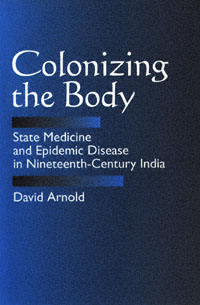 | Title: Colonizing the body: state medicine and epidemic disease in nineteenth-century India Author: Arnold, David 1946- Published: University of California Press, 1993 Subjects: Asian Studies | South Asia | Asian History | Medicine | History Publisher's Description: In this innovative analysis of medicine and disease in colonial India, David Arnold explores the vital role of the state in medical and public health activities, arguing that Western medicine became a critical battleground between the colonized and the colonizers.Focusing on three major epidemic diseases - smallpox, cholera, and plague - Arnold analyzes the impact of medical interventionism. He demonstrates that Western medicine as practiced in India was not simply transferred from West to East, but was also fashioned in response to local needs and Indian conditions.By emphasizing this colonial dimension of medicine, Arnold highlights the centrality of the body to political authority in British India and shows how medicine both influenced and articulated the intrinsic contradictions of colonial rule. [brief] Similar Items |
| 7. | 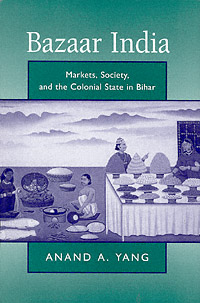 | Title: Bazaar India: markets, society, and the colonial state in Gangetic Bihar Author: Yang, Anand A Published: University of California Press, 1999 Subjects: Asian Studies | South Asia | Asian History | Economics and Business Publisher's Description: The role of markets in linking local communities to larger networks of commerce, culture, and political power is the central element in Anand A. Yang's provocative and original study. Yang uses bazaars in the northeast Indian state of Bihar during the colonial period as the site of his investigation. The bazaar provides a distinctive locale for posing fundamental questions regarding indigenous societies under colonialism and for highlighting less familiar aspects of colonial India.At one level, Yang reconstructs Bihar's marketing system, from its central place in the city of Patna down to the lowest rung of the periodic markets. But he also concentrates on the dynamics of exchanges and negotiations between different groups and on what can be learned through the "voices" of people in the bazaar: landholders, peasants, traders, and merchants. Along the way, Yang uncovers a wealth of details on the functioning of rural trade, markets, fairs, and pilgrimages in Bihar.A key contribution of Bazaar India is its many-stranded narrative history of some of South Asia's primary actors over the past two centuries. But Yang's approach is not that of a detached observer; rather, his own voice is engaged with the voices of the past and with present-day historians. By focusing on the world beyond the mud walls of the village, he widens the imaginative geography of South Asian history. Readers with an interest in markets, social history, culture, colonialism, British India, and historiographic methods will welcome his book. [brief] Similar Items |
| 8. | 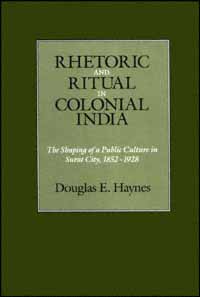 | Title: Rhetoric and ritual in colonial India: the shaping of a public culture in Surat City, 1852-1928 Author: Haynes, Douglas E Published: University of California Press, 1991 Subjects: History | Asian History | South Asia | Cultural Anthropology Publisher's Description: This book explores the rhetoric and ritual of Indian elites undercolonialism, focusing on the city of Surat in the Bombay Presidency. It particularly examines how local elites appropriated and modified the liberal representative discourse of Britain and thus fashioned a "public' culture that excluded the city's underclasses. Departing from traditional explanations that have seen this process as resulting from English education or radical transformations in society, Haynes emphasizes the importance of the unequal power relationship between the British and those Indians who struggled for political influence and justice within the colonial framework. A major contribution of the book is Haynes' analysis of the emergence and ultimate failure of Ghandian cultural meanings in Indian politics after 1923.The book addresses issues of importance to historians and anthropologists of India, to political scientists seeking to understand the origins of democracy in the "Third World," and general readers interested in comprehending processes of cultural change in colonial contexts. [brief] Similar Items |
| 9. | 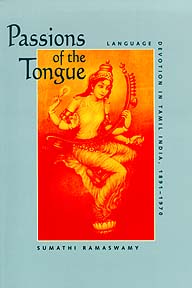 | Title: Passions of the tongue: language devotion in Tamil India, 1891-1970 Author: Ramaswamy, Sumathi Published: University of California Press, 1997 Subjects: Asian Studies | History | South Asia | Language and Linguistics | Asian History | Asian Literature Publisher's Description: Why would love for their language lead several men in southern India to burn themselves alive in its name? Passions of the Tongue analyzes the discourses of love, labor, and life that transformed Tamil into an object of such passionate attachment, producing in the process one of modern India's most intense movements for linguistic revival and separatism. Sumathi Ramaswamy suggests that these discourses cannot be contained within a singular metanarrative of linguistic nationalism and instead proposes a new analytic, "language devotion." She uses this concept to track the many ways in which Tamil was imagined by its speakers and connects these multiple imaginings to their experience of colonial and post-colonial modernity. Focusing in particular on the transformation of the language into a goddess, mother, and maiden, Ramaswamy explores the pious, filial, and erotic aspects of Tamil devotion. She considers why, as its speakers sought political and social empowerment, metaphors of motherhood eventually came to dominate representations of the language. [brief] Similar Items |
| 10. | 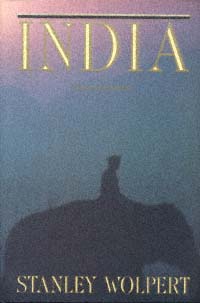 | Title: India Author: Wolpert, Stanley A 1927- Published: University of California Press, 1990 Subjects: History | South Asia | Asian History Publisher's Description: The history of India is the engrossing story of an ancient civilization, reborn as a modern nation. More a continent than a single nation, India is home to over one-fifth of humanity, yet it remains a mystery to most non-Indians, barely appreciated and poorly understood. Stanley Wolpert's India provides a much-needed, concise overview of Indian history and culture. His new preface brings the book up to date, discussing national elections, the economic effects of the new globalization, and the consequences of joining the nuclear arms race. [brief] Similar Items |
| 11. | 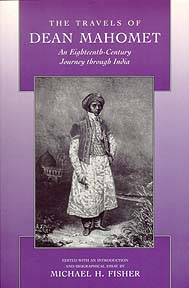 | Title: The travels of Dean Mahomet: an eighteenth-Century journey through India Author: Mahomet, Sake Deen 1759-1851 Published: University of California Press, 1997 Subjects: History | Asian History | South Asia | Travel | Autobiographies and Biographies Publisher's Description: This unusual study combines two books in one: the 1794 autobiographical travel narrative of an Indian, Dean Mahomet, recalling his years as camp-follower, servant, and subaltern officer in the East India Company's army (1769 to 1784); and Michael H. Fisher's portrayal of Mahomet's sojourn as an insider/outsider in India, Ireland, and England. Emigrating to Britain and living there for over half a century, Mahomet started what was probably the first Indian restaurant in England and then enjoyed a distinguished career as a practitioner of "oriental" medicine, i.e., therapeutic massage and herbal steam bath, in London and the seaside resort of Brighton. This is a fascinating account of life in late eighteenth-century India - the first book written in English by an Indian - framed by a mini-biography of a remarkably versatile entrepreneur. Travels presents an Indian's view of the British conquest of India and conveys the vital role taken by Indians in the colonial process, especially as they negotiated relations with Britons both in the colonial periphery and the imperial metropole.Connoisseurs of unusual travel narratives, historians of England, Ireland, and British India, as well as literary scholars of autobiography and colonial discourse will find much in this book. But it also offers an engaging biography of a resourceful, multidimensional individual. [brief] Similar Items |
| 12. | 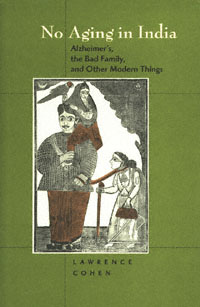 | Title: No aging in India: Alzheimer's, the bad family, and other modern things Author: Cohen, Lawrence 1961- Published: University of California Press, 1998 Subjects: Anthropology | Medical Anthropology | Aging | South Asia Publisher's Description: From the opening sequence, in which mid-nineteenth-century Indian fishermen hear the possibility of redemption in an old woman's madness, No Aging in India captures the reader with its interplay of story and analysis. Drawing on more than a decade of ethnographic work, Lawrence Cohen links a detailed investigation of mind and body in old age in four neighborhoods of the Indian city of Varanasi (Banaras) with events and processes around India and around the world. This compelling exploration of senility - encompassing not only the aging body but also larger cultural anxieties - combines insights from medical anthropology, psychoanalysis, and postcolonial studies. Bridging literary genres as well as geographic spaces, Cohen responds to what he sees as the impoverishment of both North American and Indian gerontologies - the one mired in ambivalence toward demented old bodies, the other insistent on a dubious morality tale of modern families breaking up and abandoning their elderly. He shifts our attention irresistibly toward how old age comes to matter in the constitution of societies and their narratives of identity and history. [brief] Similar Items |
| 13. | 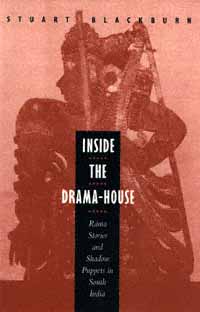 | Title: Inside the drama-house: Rama stories and shadow puppets in South India Author: Blackburn, Stuart H Published: University of California Press, 1996 Subjects: Anthropology | Asian Studies | South Asia | Cinema and Performance Arts | Hinduism Publisher's Description: Stuart Blackburn takes the reader inside a little-known form of shadow puppetry in this captivating work about performing the Tamil version of the Ramayana epic. Blackburn describes the skill and physical stamina of the puppeteers in Kerala state in South India as they perform all night for as many as ten weeks during the festival season. The fact that these performances often take place without an audience forms the starting point for Blackburn's discussion - one which explores not only this important epic tale and its performance, but also the broader theoretical issues of text, interpretation, and audience.Blackburn demonstrates how the performers adapt the narrative and add their own commentary to re-create the story from a folk perspective. At a time when the Rama story is used to mobilize political movements in India, the puppeteers' elaborate recitation and commentary presents this controversial tale from another ethical perspective, one that advocates moral reciprocity and balance.While the study of folk narrative has until now focused on tales, tellers, and tellings, this work explores the importance of audience - absent or otherwise. Blackburn's elegant translations of the most dramatic and pivotal sequences of the story enhance our appreciation of this unique example of performance art. [brief] Similar Items |
| 14. | 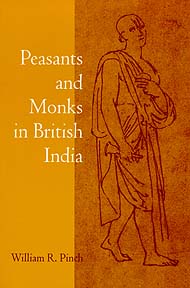 | Title: Peasants and monks in British India Author: Pinch, William R 1960- Published: University of California Press, 1996 Subjects: History | Asian History | South Asia | Postcolonial Studies | Hinduism Publisher's Description: In this compelling social history, William R. Pinch tackles one of the most important but most neglected fields of the colonial history of India: the relation between monasticism and caste. The highly original inquiry yields rich insights into the central structure and dynamics of Hindu society - insights that are not only of scholarly but also of great political significance.Perhaps no two images are more associated with rural India than the peasant who labors in an oppressive, inflexible social structure and the ascetic monk who denounces worldly concerns. Pinch argues that, contrary to these stereotypes, North India's monks and peasants have not been passive observers of history; they have often been engaged with questions of identity, status, and hierarchy - particularly during the British period. Pinch's work is especially concerned with the ways each group manipulated the rhetoric of religious devotion and caste to further its own agenda for social reform. Although their aims may have been quite different - Ramanandi monastics worked for social equity, while peasants agitated for higher social status - the strategies employed by these two communities shaped the popular political culture of Gangetic north India during and after the struggle for independence from the British. [brief] Similar Items |
| 15. | 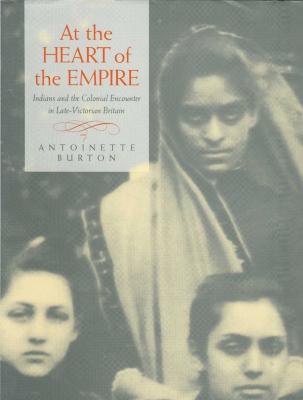 | Title: At the heart of the Empire: Indians and the colonial encounter in late-Victorian Britain Author: Burton, Antoinette M 1961- Published: University of California Press, 1998 Subjects: History | Women's Studies | Autobiographies and Biographies | South Asia | Victorian History | Travel | European History | Asian History Publisher's Description: Antoinette Burton focuses on the experiences of three Victorian travelers in Britain to illustrate how "Englishness" was made and remade in relation to imperialism. The accounts left by these three sojourners - all prominent, educated Indians - represent complex, critical ethnographies of "native" metropolitan society and offer revealing glimpses of what it was like to be a colonial subject in fin-de-siècle Britain. Burton's innovative interpretation of the travelers' testimonies shatters the myth of Britain's insularity from its own construction of empire and shows that it was instead a terrain open to continual contest and refiguration.Burton's three subjects felt the influence of imperial power keenly during even the most everyday encounters in Britain. Pandita Ramabai arrived in London in 1883 seeking a medical education and left in 1886, having resisted the Anglican Church's attempts to make her an evangelical missionary. Cornelia Sorabji went to Oxford to study law and became the first Indian woman to be called to the Bar. Behramji Malabari sought help for his Indian reform projects in England, and subjected London to colonial scrutiny in the process. Their experiences form the basis of this wide-ranging, clearly written, and imaginative investigation of diasporic movement in the colonial metropolis. [brief] Similar Items |
| 16. | 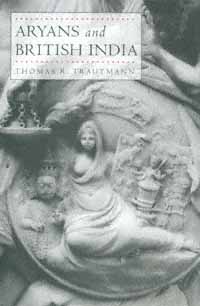 | Title: Aryans and British India Author: Trautmann, Thomas R Published: University of California Press, 1997 Subjects: History | South Asia | Asian History | European History Publisher's Description: "Aryan," a word that today evokes images of racial hatred and atrocity, was first used by Europeans to suggest bonds of kinship, as Thomas Trautmann shows in his far-reaching history of British Orientalism and the ethnology of India. When the historical relationship uniting Sanskrit with the languages of Europe was discovered, it seemed clear that Indians and Britons belonged to the same family. Thus the Indo-European or Aryan idea, based on the principle of linguistic kinship, dominated British ethnological inquiry.In the nineteenth century, however, an emergent biological "race science" attacked the authority of the Orientalists. The spectacle of a dark-skinned people who were evidently civilized challenged Victorian ideas, and race science responded to the enigma of India by redefining the Aryan concept in narrowly "white" racial terms. By the end of the nineteenth century, race science and Orientalism reached a deep and lasting consensus in regard to India, which Trautmann calls "the racial theory of Indian civilization," and which he undermines with his powerful analysis of colonial ethnology in India. His work of reassessing British Orientalism and the Aryan idea will be of great interest to historians, anthropologists, and cultural critics. [brief] Similar Items |
| 17. | 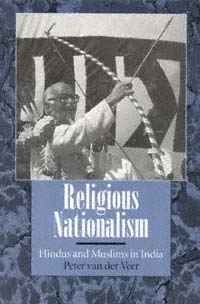 | Title: Religious nationalism: Hindus and Muslims in India Author: Veer, Peter van der Published: University of California Press, 1994 Subjects: Anthropology | Cultural Anthropology | Hinduism | South Asia Publisher's Description: Religious nationalism is a subject of critical importance in much of the world today. Peter van der Veer's timely study on the relationship between religion and politics in India goes well beyond other books on this subject. He brings together several disciplines - anthropology, history, social theory, literary studies - to show how Indian religious identities have been shaped by pilgrimage, migration, language development, and more recently, print and visual media.Van der Veer's central focus is the lengthy dispute over the Babari mosque in Ayodhya, site of a bloody confrontation between Hindus and Muslims in December 1992. A thought-provoking range of other examples describes the historical construction of religious identities: cow protection societies and Sufi tombs, purdah and the political appropriation of images of the female body, Salman Rushdie and the role of the novel in nationalism, Mahatma Gandhi and Swami Vivekananda, the Khalsa movement among Sikhs, and nationalist archaeology and the televised Ramayana .Van der Veer offers a new perspective on the importance of religious organization and the role of ritual in the formation of nationalism. His work advances our understanding of contemporary India while also offering significant theoretical insights into one of the most troubling issues of this century. [brief] Similar Items |
| 18. | 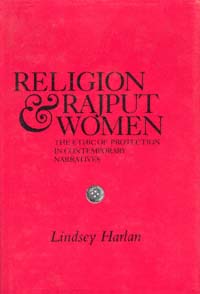 | Title: Religion and Rajput women: the ethic of protection in contemporary narratives Author: Harlan, Lindsey Published: University of California Press, 1991 Subjects: Religion | Hinduism | Cultural Anthropology Publisher's Description: What is the relationship between caste and gender in the narratives of Rajput woman? During a year and a half of fieldwork in Rajasthan, a parched land dominated by the great Indian Desert, Lindsey Harlan interviewed more than a hundred women from all levels of Rajput society. She wanted to understand why certain religious practices were so important to Rajput women, and how they justified these to themselves. During the course of her interviews, the women described their religious practices - chief among them the worship of the family kuldevi (the goddess who exemplifies the ideal wife by staving off sickness, poverty, and infertility) and the veneration of satimatas (women who have immolated themselves on their husband's funeral pyre). As the women discussed these rituals, many of them also told Harlan religious myths and stories, drawing parallels between their behavior and that of various Indian heroines. These narratives and the role they play in the women's self-perception are the fascinating and enlightening subject of this book. [brief] Similar Items |
| 19. | 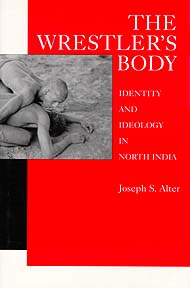 | Title: The wrestler's body: identity and ideology in north India Author: Alter, Joseph S Published: University of California Press, 1992 Subjects: Anthropology | South Asia Publisher's Description: The Wrestler's Body tells the story of a way of life organized in terms of physical self-development. While Indian wrestlers are competitive athletes, they are also moral reformers whose conception of self and society is fundamentally somatic. Using the insights of anthropology, Joseph Alter writes an ethnography of the wrestler's physique that elucidates the somatic structure of the wrestler's identity and ideology.Young men in North India may choose to join an akhara, or gymnasium, where they subject themselves to a complex program of physical and moral fitness. Alter's first-hand description of each detail of the wrestler's regimen offers a unique perspective on South Asian culture and society. Wrestlers feel that moral reform of Indian national character is essential and advocate their way of life as an ideology of national health. Everyone is called on to become a wrestler and build collective strength through self-discipline. [brief] Similar Items |
| 20. | 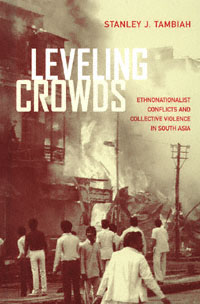 | Title: Leveling crowds: ethnonationalist conflicts and collective violence in South Asia Author: Tambiah, Stanley Jeyaraja 1929- Published: University of California Press, 1997 Subjects: Anthropology | South Asia | Politics | Asian History | Religion Publisher's Description: Ethno-nationalist conflicts are rampant today, causing immense human loss. Stanley J. Tambiah is concerned with the nature of the ethno-nationalist explosions that have disfigured so many regions of the world in recent years. He focuses primarily on collective violence in the form of civilian "riots" in South Asia, using selected instances in Sri Lanka, Pakistan, and India. He situates these riots in the larger political, economic, and religious contexts in which they took place and also examines the strategic actions and motivations of their principal agents. In applying a wide range of social theory to the problems of ethnic and religious violence, Tambiah pays close attention to the history and culture of the region.On one level this provocative book is a scrupulously detailed anthropological and historical study, but on another it is an attempt to understand the social and political changes needed for a more humane order, not just in South Asia, but throughout the world. [brief] Similar Items |